What Is an Agile Portfolio Management?
Agile portfolio management refers to applying Agile principles and practices to manage a portfolio of projects. It involves aligning strategy and execution, improving transparency across a portfolio of projects, and embracing cross-team collaboration and continuous improvement.
Adopting Agile principles to portfolio management has been a trend for the past years since the increasing popularity of the Agile way of working. As more and more companies from all business sectors realize the effectiveness of Agile practices, they are looking to spread them across different organizational levels, not just on a team level.
In the following paragraphs, we will explore:
- how Agile portfolio management differs from the traditional approach of managing work;
- what the concept of managing an Agile portfolio entails;
- and how to implement it in practice.
Traditional vs. Agile Portfolio Management
To begin with, let’s first clarify what exactly a portfolio is.
By definition, a portfolio usually represents a collection of projects, products, investments, programs, etc., in a single business unit inside the organization. In turn, the process of managing that portfolio is all about identifying projects for execution and prioritizing them to ensure that the right things are done at the right time.
 Image Credit: https://www.pmi.org/
Image Credit: https://www.pmi.org/
Let's find out how this is handled by different management approaches.
Traditional Portfolio Management
Traditionally, portfolio prioritization happens by planning a detailed project roadmap and then applying budgets based on those plans. Once funding is approved, the portfolio is implemented.
The approach requires heavy upfront planning for the projects to be approved, and in today's highly volatile business environment, it’s risky to rely on that. Despite this, many organizations try to start as many projects as possible at once, which has its downsides.
When too many projects are in progress, teams get easily overburdened by switching between many priorities, resulting in low productivity.
Low transparency of the management process is another threat, which can also lead to misalignment between the company's strategy and its execution.
Agile Portfolio Management
To deal with the challenges in the face of the traditional approach, the Agile portfolio management process applies the “test, learn and adapt” principles and decentralized control on a portfolio level.
Identifying priorities in Agile, for instance, happens through rapid feedback loops. Portfolio managers regularly review a particular set of projects and assess how they align with the strategic initiatives. They also frequently engage in collaborative discussions with project managers or different team leaders to identify small experiments to evaluate projects or improve a given product/service delivery. This allows them to gather fast feedback and make data-driven decisions.
Moreover, instead of preparing highly detailed project roadmaps to apply for budgets, Agile portfolio management entails planning on multiple levels and cascading power downwards. In turn, financial resources are allocated towards experiments and value streams within the organization rather than separate projects.

While the traditional portfolio management approach supports planning in advance and strict budget allocation, the Agile way of managing a portfolio of projects promotes flexibility. This Agile planning enables portfolio managers to reallocate funds to emerging priorities based on changing customer requirements or new ideas that can be more valuable than the old ones.
Main Pillars of Agile Portfolio Management
To sustain agility within their operations, Agile organizations:
- focus on maintaining transparency,
- continuously experiment to determine whether a project is valuable, and
- align strategy with execution.
Combined, these goals form Agile portfolio management's three main pillars. Let's break them down and briefly discuss each one of them below.
1. Scaled Transparency
Creating transparency in the portfolio and overall project management processes is critical in today's rapidly changing business environment.
Traditionally, there is a big emphasis on detailed status reporting performed by portfolio or project managers. The problem is that this takes a lot of valuable time, and often the reporting turns out to be wrong because it's reliant on flawed estimations.
Agile, in turn, focuses on creating a shared purpose for everyone to follow both from a strategic and project management point of view. By implementing connected visual boards, portfolio managers can easily capture ideas for multiple projects and create a shared understanding of what's happening inside the portfolio. The desired outcome is to establish an open environment where all concerned parties can quickly check the status of a project and thus reduce the need for preparing extensive reports.
 Visualizing connected visual boards
Visualizing connected visual boards
Furthermore, rather than estimating based on gut feeling, Agile promotes forecasting project plans that the teams progressively refine. The idea is to take actual data into account and retain the flexibility to update the plans based on new information.
2. Continuous Experimentation & Agile Portfolio Prioritization
When having a set of project ideas, it may be challenging to determine which ones are more important than others at a given moment. A bad practice would be to start working on all of them, as the chance of overloading your teams is high, and the risk of project failure increases. To prevent that, you need to learn how to pick only the most valuable ones and prioritize them accordingly.
Here comes the concept of rapid experimentation that is central in an Agile environment. To determine whether a given project is worth pursuing, you can run small experiments as part of its validation process. The idea is to quickly gather data before rushing to make any big commitments, only to find out that the chosen project will not bring the expected value.
Other than that, it's not uncommon to end up with a bunch of validated projects which are all highly valuable. How do you decide which one of them to execute first then?
For that, you can use the powerful concept of cost of delay (CoD) to make sequencing decisions. It's based on pure economics and shows how much money you would lose if you delayed project delivery.
So, as a rule of thumb, the higher the cost of delay, the higher the priority of a given project. In case two or more projects have the same cost of delay, you should start with the shortest one. However, keep in mind that you should use the cost of delay as an input to other variables (such as market and technical risks) rather than a "one-size-fits-all" solution.
3. Aligning Strategy and Execution
Another central pillar of Agile portfolio management is achieving alignment between strategy and execution, where the portfolio connects the two.
Therefore, effective portfolio management requires a way to align the highest business objectives with the project execution.
To do this in practice, the Agile culture promotes frequent feedback loops that can be applied globally (across the company's management) and locally (across teams). You can review strategy, project risks, and delivery capabilities by creating a network of these short planning and learning cycles on multiple organizational levels.
This allows you to quickly adapt to high-level changes and shift your operations towards the most critical priority whenever necessary.
How to Manage an Agile Portfolio in Practice?
To create an Agile portfolio management process in reality, you need a complete management system to visualize, prioritize, and align your portfolio projects with the company's strategic initiatives. This is where the workflow management method Kanban steps in to help you put theory into practice.
Apply Kanban at the Portfolio Level
Kanban’s primary focus is on visualization, limiting work in progress, managing flow, and continuous improvement. These can be applied on multiple levels inside the company, including the portfolio. This is done through the concept of Portfolio Kanban, which allows you to track and optimize the flow of different business initiatives, single or multiple projects, or entire products.
 Visualization of the Kanban practices applied at a project, program, and portfolio-level
Visualization of the Kanban practices applied at a project, program, and portfolio-level
1. Connect Strategy, Portfolio, and Project Execution
As mentioned above, one of the main themes in Agile portfolio management is creating visibility inside the portfolio. This will allow you to maintain a shared understanding of the project's status and progress toward success. Ultimately, the idea is to bridge the gap between high-level planning and operations to execute your organization's strategy.
In practice, strategic portfolio management can happen through the implementation of related Kanban boards. You can use them to visualize initiatives and themes, multiple projects, project deliverables, or individual tasks.
Let's take a quick example with an R&D department inside an organization.
To visualize chosen initiatives or multiple projects based on their strategy, portfolio managers can build a dedicated Portfolio Kanban board. Depending on the scale of those projects or initiatives, they can be further broken down into sub-projects within the same board or a different one. To tie this structure together, in Kanbanize by Businessmap, we use parent-child project relationships.
Visualizing a dedicated Portfolio Kanban board
Progressing down to lower levels, you can keep using related Kanban boards to visualize different parts of the department or even the entire organization. Those can be program or project management processes going all the way down to the individual tasks that team members are responsible for. The idea is to create a central hub and keep track of your portfolio without losing sight of its execution across multiple teams.
In Businessmap, for example, we combine Management and Team Workspaces to visualize and connect project planning and daily operational activities across teams. This will allow you to achieve unmatched transparency over multiple projects.
 Connecting strategic portfolio management with operations using the Portfolio Kanban concept
Connecting strategic portfolio management with operations using the Portfolio Kanban concept
2. Manage the Portfolio Flow
Once you have your Portfolio Kanban board set up, another important part is managing the project flow from concept to fruition.
In Kanban, we do that by mapping the value stream of all our processes. By implementing different commitment points, for example, you can signify the point in your process where a project has been committed for refinement, execution or it's ready for customer delivery.
 Visualizing commitment points on a Portfolio Kanban board
Visualizing commitment points on a Portfolio Kanban board
It's important to note the refinement part before the "Ready to Start" column on the Kanban board. This is essentially an Upstream Kanban process where each project request represents an option portfolio managers should validate before committing to execution. At this stage in the flow, you can buy some extra time to gather more details and make a proper decision about engaging or not in a project based on new data.
This is an excellent moment for running experiments to make reasonable decisions.
Another best practice for managing portfolio flow is to limit projects in progress. Doing this will allow you to relieve your teams from overburdening and match the incoming demand with real capabilities. As a result, you will ensure that the team's attention is directed towards the most critical initiatives at any given moment, and this way, focus on improving your global throughput.
 Limiting projects in progress on a Portfolio Kanban board
Limiting projects in progress on a Portfolio Kanban board
3. Review The Portfolio on a Regular Basis
Revisiting your portfolio of projects in a regular cadence is an integral part of Agile portfolio management. To do this, Kanban uses of feedback loops/ cadences on a portfolio level.
The idea is to regularly review the status of the projects, products, or services in progress and engage in collaborative discussions with middle managers on things such as identified dependencies or risks, available capacity across the structure, and needs for shared resources. This input should be aggregated by lower-level cadences spanning multiple teams across a department or the entire organization.
 Kanban cadences or feedback loops for planning and improvement
Kanban cadences or feedback loops for planning and improvement
Applying a regular portfolio cadence within management meetings and using Portfolio Kanban boards to visualize what’s important allows managers to prioritize new projects and initiatives and sync whether they adapt with the company's strategy. Agile cadences at the portfolio level allow managers to adapt to strategic changes of direction and ensure that the right things are done at the right time.
4. Analyze Metrics for Continuous Improvement
Like everything else that turns into a success, Agile portfolio management also requires continuous improvement. That's why you need to have a way to collect data and analyze it to make better decisions.
In a Kanban system, you can do that by measuring different Lean/Agile metrics such as lead and cycle time, throughput, and WIP (Work in Progress). With the help of various charts such as Cycle Time Scatterplots, you can monitor when the projects inside your portfolio get done and with what time probability they are likely to flow through your system on average. This helps you spot outliers and emerging trends so you can take any necessary precautions or discuss improvements in the management process.
 Visualization of when a work item is completed using the Cycle Time Scatterplot
Visualization of when a work item is completed using the Cycle Time Scatterplot
Furthermore, combining that data with a powerful technique such as Monte Carlo Simulations will allow you to make probabilistic forecasting based on historical data rather than estimations derived from a gut feeling.
As a result, you will have a way to derive possible outcomes for the delivery of multiple projects inside your portfolio based on your team's real capabilities for executing them.
 Example of Monte Carlo: How Many
Example of Monte Carlo: How Many
We offer the most flexible software platform
for outcome-driven enterprise agility.
In Summary
Agile portfolio management is a more flexible way of managing a portfolio of projects, programs, initiatives, etc., by focusing on decentralized control, transparency, continuous experimentation, prioritization, and better alignment between strategy and execution. Building an effective Agile portfolio management process requires you to have a complete management system in place so you can:
- Bridge the gap between strategy, portfolio, and project execution;
- Manage portfolio flow;
- Engage in regular cadences/feedback loops (such as Portfolio Reviews) to adapt to changes;
- Analyze metrics and continuously improve.





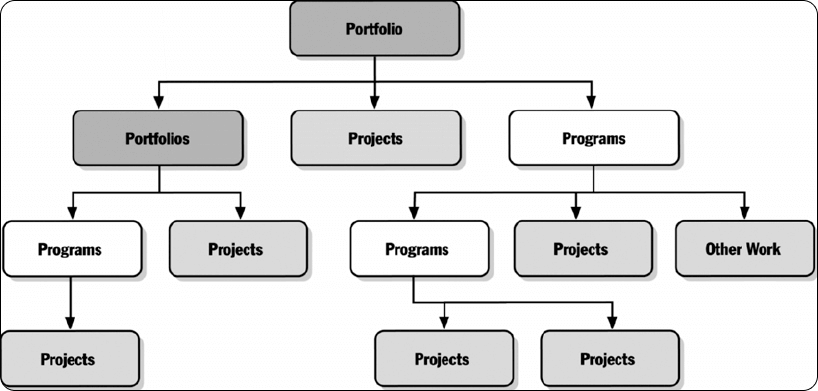 Image Credit:
Image Credit: 
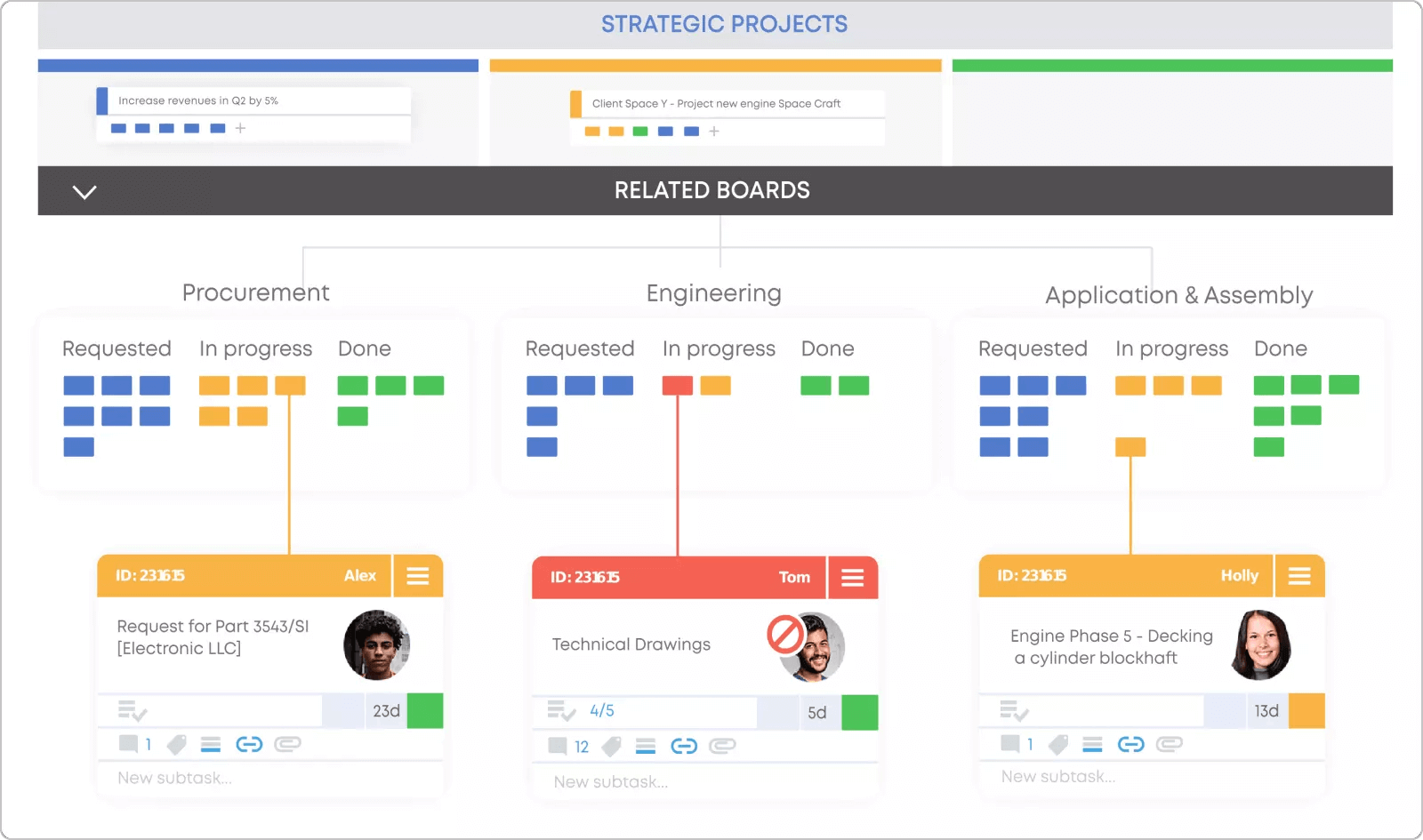 Visualizing connected visual boards
Visualizing connected visual boards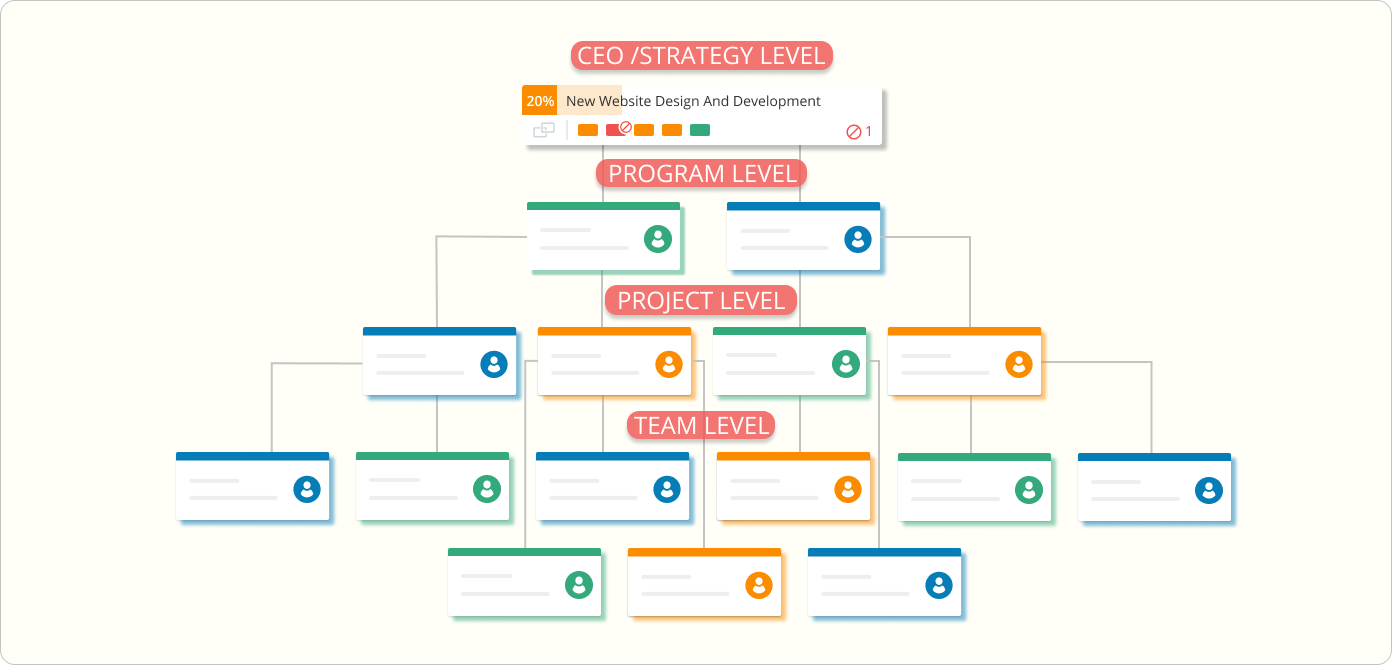 Visualization of the Kanban practices applied at a project, program, and portfolio-level
Visualization of the Kanban practices applied at a project, program, and portfolio-level 
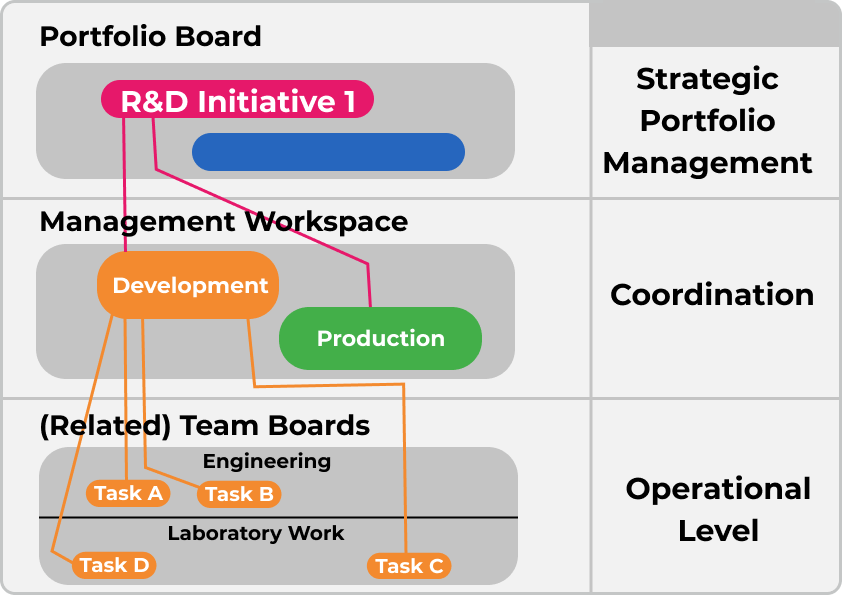 Connecting strategic portfolio management with operations using the Portfolio Kanban concept
Connecting strategic portfolio management with operations using the Portfolio Kanban concept 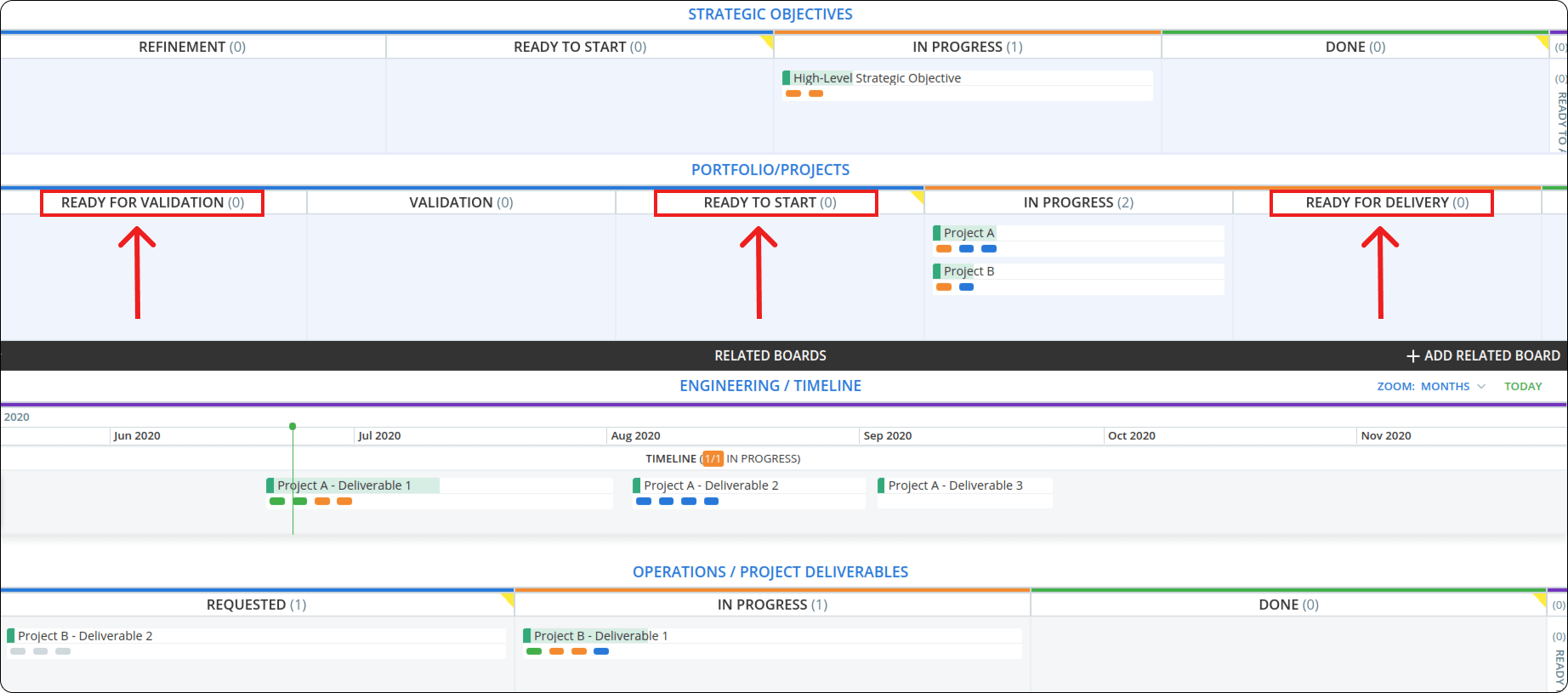 Visualizing commitment points on a Portfolio Kanban board
Visualizing commitment points on a Portfolio Kanban board Limiting projects in progress on a Portfolio Kanban board
Limiting projects in progress on a Portfolio Kanban board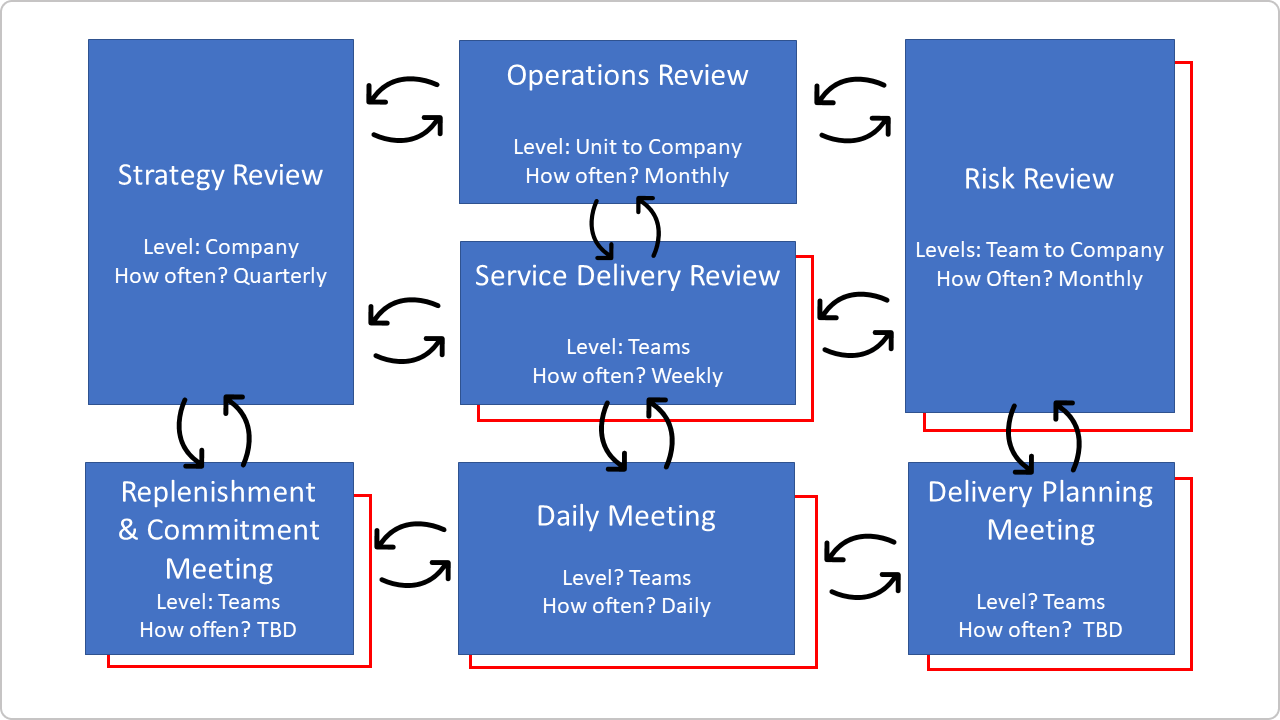 Kanban cadences or feedback loops for planning and improvement
Kanban cadences or feedback loops for planning and improvement Visualization of when a work item is completed using the Cycle Time Scatterplot
Visualization of when a work item is completed using the Cycle Time Scatterplot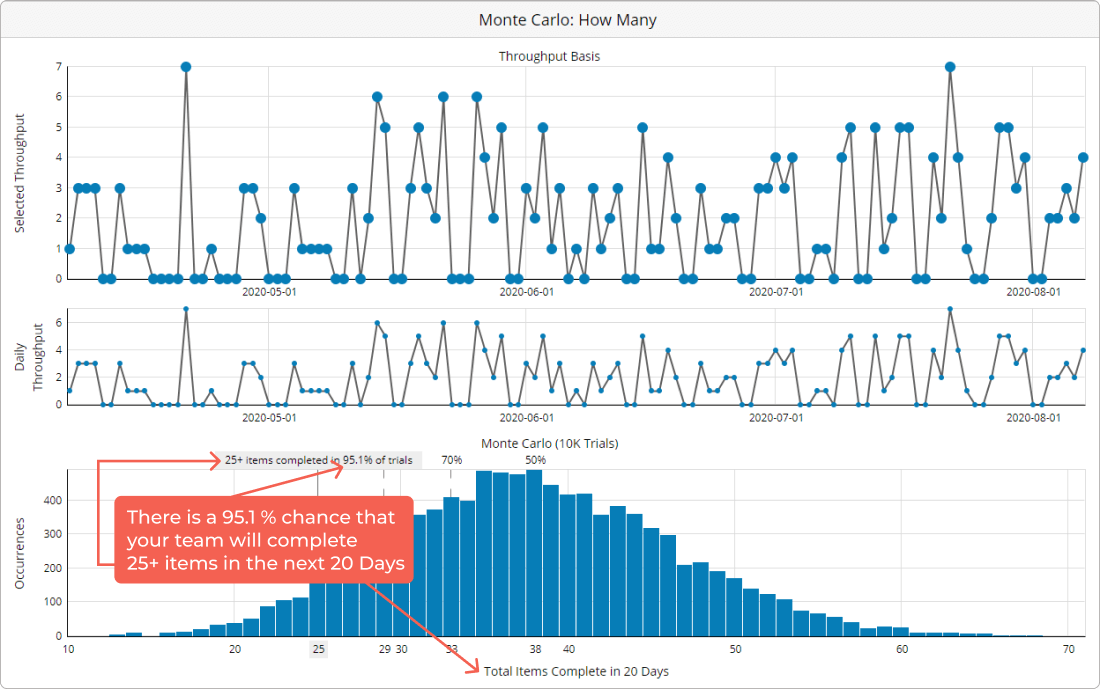 Example of Monte Carlo: How Many
Example of Monte Carlo: How Many 

